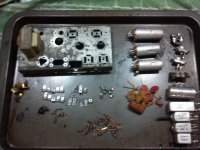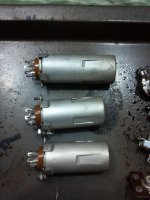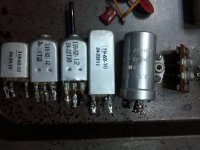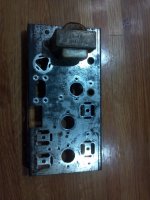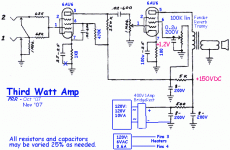This is my first post here and I am a self confessed newbie to the tube amp and electric guitar world. I am buying my 14 yo son a guitar for Christmas, (Yamaha PAC112V) and would like to do a DIY tube amp project with him for educational purposes and to keep things affordable. I have a lot of old vintage audio gear around I can steal parts from and cannibalize to get what we need as well as a surplus of speakers.
This amp will primarily be for practice purposes and high power is neither needed or desired. 1w-3w of output would be more than plenty.
I would like to use an old Lafayette LT220 Multiplex adapter as the donor for this project. As I said, I know little to nothing about tube amps but it appears to have the basics I think might be needed. Metal Chassis base, transformer, tube sockets, and tubes 1-12ax7 (Telefunken, Germany) 1- 6BN (Lafayette/RCA) and 1- 12AU7.
There are two on/off switches and a small red indicator light. Here are some pictures of an identical unit (tubes removed).
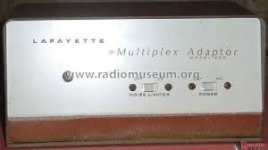
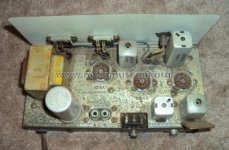
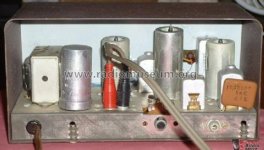
A schematic for the unit is available here: LAFAYETTE KT-220 LT220 FM STEREO MULTIPLEX ADAPTER SCH Service Manual free download, schematics, eeprom, repair info for electronics
My vision is to gut anything that isn't neccesary, re-wire it to serve its new purpose add a volume and tone control along with the neccessary caps, resistors, diodes, a headphone jack and two small speakers and maybe build a nice heavy polished wood base for it.
1. Is this possible using this donor and tubes?
2. Providing the transformer and tubes work what else do I need to build the preamp/amp.
3. Is this something forum members would be willing to walk us through and provide ideas on layout and a basic schematic?
4. What more information do I need to provide?
5. Is there a portion of this forum that might already have proven designs using these tubes I should look at first?
I am accomplished in all wire wrapping, soldering/desoldering, metalwork, woodwork, speaker building, etc. and have done solid state projects in the past, just never with tubes, although I have a deep appreciation for the sound of tubes. I also have knowledge of working with high voltages.
If this is not feasible, I might build a solid state amp similar to the 1W punch amp based on a TDA7052A but I think the tube amp would be a lot more fun to build.
Thanks!
This amp will primarily be for practice purposes and high power is neither needed or desired. 1w-3w of output would be more than plenty.
I would like to use an old Lafayette LT220 Multiplex adapter as the donor for this project. As I said, I know little to nothing about tube amps but it appears to have the basics I think might be needed. Metal Chassis base, transformer, tube sockets, and tubes 1-12ax7 (Telefunken, Germany) 1- 6BN (Lafayette/RCA) and 1- 12AU7.
There are two on/off switches and a small red indicator light. Here are some pictures of an identical unit (tubes removed).



A schematic for the unit is available here: LAFAYETTE KT-220 LT220 FM STEREO MULTIPLEX ADAPTER SCH Service Manual free download, schematics, eeprom, repair info for electronics
My vision is to gut anything that isn't neccesary, re-wire it to serve its new purpose add a volume and tone control along with the neccessary caps, resistors, diodes, a headphone jack and two small speakers and maybe build a nice heavy polished wood base for it.
1. Is this possible using this donor and tubes?
2. Providing the transformer and tubes work what else do I need to build the preamp/amp.
3. Is this something forum members would be willing to walk us through and provide ideas on layout and a basic schematic?
4. What more information do I need to provide?
5. Is there a portion of this forum that might already have proven designs using these tubes I should look at first?
I am accomplished in all wire wrapping, soldering/desoldering, metalwork, woodwork, speaker building, etc. and have done solid state projects in the past, just never with tubes, although I have a deep appreciation for the sound of tubes. I also have knowledge of working with high voltages.
If this is not feasible, I might build a solid state amp similar to the 1W punch amp based on a TDA7052A but I think the tube amp would be a lot more fun to build.
Thanks!
Last edited:
the power transformer on that has a very low output even with a bridge rectifier, don't think you will have enough volts and you WILL need an output transformer. I recomend you take a look at https://robrobinette.com/Deluxe_Micro.htm you may have many of the parts and this is a cheap build.
Last edited:
the power transformer on that has a very low output even with a bridge rectifier, don't think you will have enough volts and you WILL need an output transformer. I recomend you take a look at https://robrobinette.com/Deluxe_Micro.htm you may have many of the parts and this is a cheap build.
Thanks! Will take a look at that.
OK, I looked at the "Deluxe Micro" layout and schematic as well as taking a listen to the sound clips. I definitely think it is doable. Based on what I am seeing there, I can use both my 12AX7 (in place of the 12AY7) and the 12AU7 that are in the LT200 unit. This morning I did a little more scrounging in the garage to see what I could come up with. I think I scored a few more parts that might be usable.
I had an old EICO tube based, sine wave frequnecy generator that has a pair of transformers that look about right for the job, although I don't know what the actual specs are. I will try to look them up. If memory serves right, it also has either a 6L6GT or 6V6GT in it. I notice Rob shows a mod further down for it to allow this tube to be used as a rectifier in place of the EZ81. A little reading has me wondering if it wouldn't actually be a better setup (might be way wrong here) for the guitar we intend to use on it. The PAC112V tends to be a little bright and lack in the mid/mid lows which is as opposed to the Fender Strat which is fuller in the mids and that is where the 6L6 is supposed to excel. Is this faulty thinking? Is it true the EL34/EZ81's tends to be brighter and lack bass response compared to a 6L6 or 6V6? Listening to the clips, it seems like the amp with EZ81's tended to have a fuller mid-range and less bottom end.
I also pulled out an old vintage Kenwood KA-2002 amp carcass that has a decent looking power transformer, some 50K and 52K pots and some other miscellaneous switches and tidbits that might come in handy as well as complete Pioneer SA-710 and Sherwood S-7100A integrated amps. I am fine with cannibalizing any of these for the cause.
Among that miscellaneous category, I also uncovered a pair of massive toroidial transformers. They are labelled as monophase, 50-60hz, 350VA 0-180-230-480Volt
and also a few 110V-240Vsolid state power supplies.
5VDC-6.0A
12VDC -1.0A or 15VDC -0.8A
24VDC- 2.4A
I also have a few laptop computer power transformers at my disposal.
If any of these pieces are useable or would steer towards another approach let me know. Thanks again.
I had an old EICO tube based, sine wave frequnecy generator that has a pair of transformers that look about right for the job, although I don't know what the actual specs are. I will try to look them up. If memory serves right, it also has either a 6L6GT or 6V6GT in it. I notice Rob shows a mod further down for it to allow this tube to be used as a rectifier in place of the EZ81. A little reading has me wondering if it wouldn't actually be a better setup (might be way wrong here) for the guitar we intend to use on it. The PAC112V tends to be a little bright and lack in the mid/mid lows which is as opposed to the Fender Strat which is fuller in the mids and that is where the 6L6 is supposed to excel. Is this faulty thinking? Is it true the EL34/EZ81's tends to be brighter and lack bass response compared to a 6L6 or 6V6? Listening to the clips, it seems like the amp with EZ81's tended to have a fuller mid-range and less bottom end.
I also pulled out an old vintage Kenwood KA-2002 amp carcass that has a decent looking power transformer, some 50K and 52K pots and some other miscellaneous switches and tidbits that might come in handy as well as complete Pioneer SA-710 and Sherwood S-7100A integrated amps. I am fine with cannibalizing any of these for the cause.
Among that miscellaneous category, I also uncovered a pair of massive toroidial transformers. They are labelled as monophase, 50-60hz, 350VA 0-180-230-480Volt
and also a few 110V-240Vsolid state power supplies.
5VDC-6.0A
12VDC -1.0A or 15VDC -0.8A
24VDC- 2.4A
I also have a few laptop computer power transformers at my disposal.
If any of these pieces are useable or would steer towards another approach let me know. Thanks again.
This devise has been designed to manage low level signals, not power like a speaker output. So, no output power tube.
Osvaldo, Thank you for the reply. Forgive my ignorance but what "device" exactly are you referring to?
Are you saying the input power rectifier tube is not in the signal path and therefore would have no effect on the tonality of the amps audio output and therefore either 6V6, EZ81 or EC34 would work all the same other than bias, current load and heat output?
Found schematic on the eico frequency Generator. According to it, the Power Transformer puts out 275-0-275 on the secondary which is exactly what I need but the B-2 is 48V rather than 6.3. Should I use an independent transformer for the 6.3v or is there a way to make this work?
I would recommend having a look at the Mullard 3-3 amplifier. Though not a guitar amp it is a very good design. I recently built a Class single ended 3w amplifier, see here - Single ended amplier It's not perfect but worked ok. You'll learn a lot more if you design your own than following an existing build.. Make sure your OPT is designed for single ended use, IE has gaps between lamination's.
48v? You might be able to run the valve heaters in series = 8 valves or two 12AX7's and two OP valves. The problem is finding OP valves with 12v htr's; you could use P type TV valves. The problem is, what is the 48v windings current capability? You might be able to wind a few turns on the tfmr to give you 6.3v, about 20 turns.
The thing is, it's not ideal, you'd be better off with a proper HT/B+ transformer. I've often found it's more expensive and time consuming to try and make a non ideal transformer fit than buying the proper tfmr in the first place. Also it seems sad to hack an Eico sig gen when it would be of more use to you in one piece.
Good luck, Andy.
48v? You might be able to run the valve heaters in series = 8 valves or two 12AX7's and two OP valves. The problem is finding OP valves with 12v htr's; you could use P type TV valves. The problem is, what is the 48v windings current capability? You might be able to wind a few turns on the tfmr to give you 6.3v, about 20 turns.
The thing is, it's not ideal, you'd be better off with a proper HT/B+ transformer. I've often found it's more expensive and time consuming to try and make a non ideal transformer fit than buying the proper tfmr in the first place. Also it seems sad to hack an Eico sig gen when it would be of more use to you in one piece.
Good luck, Andy.
Osvaldo, Thank you for the reply. Forgive my ignorance but what "device" exactly are you referring to?
I refer in such a way to the entire apparatus, chassis, transformer, tubes, sockets, screws, etc.
In those days, FM receivers were mono, and as the FM becomes stereo, then manufactures offered separate devices, as your's to get stereophony at home.
I know nowadays you have all it in a phone cell, but this time, not.
I refer in such a way to the entire apparatus, chassis, transformer, tubes, sockets, screws, etc.
In those days, FM receivers were mono, and as the FM becomes stereo, then manufactures offered separate devices, as your's to get stereophony at home.
I know nowadays you have all it in a phone cell, but this time, not.
Oh, OK Osvaldo, that makes sense now. I think I may have misled some people in my first post. I understand what the original device did and how it worked and did not mean to make anyone think I intended in any way to use it in its original form as a guitar amplifier with just adding a few parts.
My intent was to use it as a starting point and parts donor for the project. I have seen numerous micro guitar amps made using some of the tubes this unit has. I intended to "Cannibalize" an recycle all possible parts from the unit in order to save money and also to learn about how tube amplifiers work and what works with what.
Here are some pictures of everything now that it is broken down.
I think I can re-use 2 if not all three of the tubes, maybe the input power transformer, the tube holders and sleeves, the standoff terminals, switches and I will save the RCA connectors for another project. Resistors and capacitors are probably not worth saving?
View attachment 583046
View attachment 583047
I assume the following parts are junk and unless someone sees a logical reason they should be saved I will throw them out.
View attachment 583048
Here is the stripped chassis with just the transformer. left the leads attached so I would know which ones were which.
View attachment 583049
After reading numerous articles and videos and looking at all of the amplifiers and schematics mentioned by members and numerous others I have learned a lot and I am second guessing a few things. I think I may scrap the chassis. Not sure it will be big enough for what I need to do and the layout may compromise or cause issues or complexities I don't need. I will likely build a new chassis and just use this one for template purposes to get hole size and screw spacing correct on the new one.
The Eico 377 is missing all of the tubes except for the 6X5GT so I remembered wrong. The output tube was a 6V6 which is missing.
I am a little confused here. I read today that the first number of the tube designation is the voltage required for the heater(s). If this is the case, shouldn't the power transformer have a 6.3v circuit? The schematic does not show that. The other tubes in the unit were 6SN7, 6K6, and a 6SJ7.
The schematic shows it producing 275VAC-0-275VAC with it being bumped up to 300 by the 6X5GT then reduced again to 290. B-2 shown as 47V
It is unfortunate that the attached can't be viewed.
The work you must to do is very big for a noob. Sorry, I'm not trying you despectively, but I believe you say in a below post you just start with tubes.
Let me say that tubes uses high voltages, about 300V or still more, and if you din't pay attention, then may be burned or be lethal.
In the other hand, making an amp with a couple of tubes is easy, and when finished, and you enjoy listen to it, is very gratifying.
A simple way is to start with a 6BQ5, a 12AX7 and a rectifier, depending in the power transformer topology. Replace or discard any paper or wax capacitor, and the electrolytic. Usually they become faulty, although they can't be visible.
The trafo seems to be very little for give too much power than a 4-5 Watts of audio output.
I remark keeping a hand in the pocket while working in the powered unit, and make a current limited supply, using a filamentary lamp wired in series between line live and the DUT. If things go wrong, then lamps start lighting and decreases current for the set in trouble.
The work you must to do is very big for a noob. Sorry, I'm not trying you despectively, but I believe you say in a below post you just start with tubes.
Let me say that tubes uses high voltages, about 300V or still more, and if you din't pay attention, then may be burned or be lethal.
In the other hand, making an amp with a couple of tubes is easy, and when finished, and you enjoy listen to it, is very gratifying.
A simple way is to start with a 6BQ5, a 12AX7 and a rectifier, depending in the power transformer topology. Replace or discard any paper or wax capacitor, and the electrolytic. Usually they become faulty, although they can't be visible.
The trafo seems to be very little for give too much power than a 4-5 Watts of audio output.
I remark keeping a hand in the pocket while working in the powered unit, and make a current limited supply, using a filamentary lamp wired in series between line live and the DUT. If things go wrong, then lamps start lighting and decreases current for the set in trouble.
Last edited:
It is unfortunate that the attached can't be viewed.
The work you must to do is very big for a noob. Sorry, I'm not trying you despectively, but I believe you say in a below post you just start with tubes.
Let me say that tubes uses high voltages, about 300V or still more, and if you din't pay attention, then may be burned or be lethal.
In the other hand, making an amp with a couple of tubes is easy, and when finished, and you enjoy listen to it, is very gratifying.
A simple way is to start with a 6BQ5, a 12AX7 and a rectifier, depending in the power transformer topology. Replace or discard any paper or wax capacitor, and the electrolytic. Usually they become faulty, although they can't be visible.
The trafo seems to be very little for give too much power than a 4-5 Watts of audio output.
I remark keeping a hand in the pocket while working in the powered unit, and make a current limited supply, using a filamentary lamp wired in series between line live and the DUT. If things go wrong, then lamps start lighting and decreases current for the set in trouble.
Yes, I understand this is a pretty bold adventure for a noob. I have never been discouraged by a challenge.
I have been doing a pile of reading and studying and listening to audio clips and I think I am beginning to put together a plan. I think Dr. Wobble had some good advice on coming up with something different rather than just copying something someone else has done. Of course I don't expect this to be entirely original.
I am putting together my thoughts on the fly here so forgive me if I overlook some things.
1. Addressing the High voltage issues. Since I don't seem to have the proper transformers to do what I initially planned and this will be used by my son, I am considering a low voltage version for safety reasons and cost.
2. Since you can't do a low voltage version with a speaker level output with tubes, I am looking at a hybrid design.
So in my head right now, what I am planning is to use my regulated +12VDC 1A power supply or a discarded computer power supply. It will be isolated from the 12AX7 or 12AU7 pre-amp section. I am told that 12VDC is sufficient for low power, preamp type use on these tubes. It will be based on the "Tube Cricket" design by BRC/OLC and use an IC based output stage. Rather than the JRC386 that the tube cricket uses, I am planning to use a TDA7052A as used in the stomp box punch amp. I believe the only thing I am really lacking is a the IC which is only a couple bucks.
A similar project can be seen completed here:
Lil' Green Watter!
He has a youtube video of it and its not too bad.
I figure I can mock up the preamp and amp section I can mock up on the old chassis and test it. If it works well, I will make a custom chassis for it and a speaker cabinet.
a bonus to this design is that theoretically it could be powered off a 12v battery for short periods of time making it completely portable.
I typically abhor IC based amps but in this application I can live with some of its shortcomings. Please nobody burn me at the stake as a heretic.
I will try too post my conceptual schematic for reveiw upon completion
Assume ALL the caps are shot. You need new filter-caps (the large can). You need an output transformer, not yet found in your hunt.
Guitar level is very much lower than line level. I would not expect to put guitar input circuit that close to power transformer without major hum-trouble or massive added shielding.
Old disused tube-stuff will be a MAJOR problem with tarnish on sockets and pins. Many quality father-and-son hours with stinky solvent and pipe-cleaners.
You will expect key used tubes to be dead or hissy. A tube amp NEEDS a tube budget.
> 1w-3w of output would be more than plenty.
The MPX box power supply gives 150V 7mA. This is barely 1 Watt DC. SE tube power amp is at-best 40% efficient. On the face of it, you can only get 0.4 Watts out.
Efficiency of tubes will be lower at these low voltages.
You also need a part-mA for the preamp stage(s), so less for the power stage.
150V 7mA suggests a 21K output transformer, which is an awkwardly high-Z part. (However Fender Reverb transformer is not too far out, and not very expensive.)
The Deluxe Micro is a fine design. However being triode-output, power is even lower, maybe 1/4 Watt. And IMHO the sound of rock-n-roll is Pentodes. I have a 6AU6-base "Third Watt" plan for a whopping 0.3 Watts output. However this leads to needing 7-pin sockets (or a tube-hunt). Which may be good because IMHO you want to work on new sockets. But bad because 7-pin won't fit 9-pin punch-outs without mechanical hacks.
Seriously, a beginner does not *need* a tube amp. For most young players, a gold lame shirt will do more for their image.
Haunt the guitar and pawn shops. They take low-price beginner amps as trade-ins to lubricate an up-sale. I have seen very fine little 10W combo amps for $20. I suspected that the shop owner would take less to get the "junk" out of the shop. If you are shop-buying a guitar, it is certainly something to bring up. "Throw in a small good-working 1990s amp for my last $5." That may be a stretch for a $140(?) guitar, but maybe not. Traded-in baby Bosses and Rolands and stuff accumulates in stores, and they gotta shovel them out. $5 beats paying dumpster fees.
Guitar level is very much lower than line level. I would not expect to put guitar input circuit that close to power transformer without major hum-trouble or massive added shielding.
Old disused tube-stuff will be a MAJOR problem with tarnish on sockets and pins. Many quality father-and-son hours with stinky solvent and pipe-cleaners.
You will expect key used tubes to be dead or hissy. A tube amp NEEDS a tube budget.
> 1w-3w of output would be more than plenty.
The MPX box power supply gives 150V 7mA. This is barely 1 Watt DC. SE tube power amp is at-best 40% efficient. On the face of it, you can only get 0.4 Watts out.
Efficiency of tubes will be lower at these low voltages.
You also need a part-mA for the preamp stage(s), so less for the power stage.
150V 7mA suggests a 21K output transformer, which is an awkwardly high-Z part. (However Fender Reverb transformer is not too far out, and not very expensive.)
The Deluxe Micro is a fine design. However being triode-output, power is even lower, maybe 1/4 Watt. And IMHO the sound of rock-n-roll is Pentodes. I have a 6AU6-base "Third Watt" plan for a whopping 0.3 Watts output. However this leads to needing 7-pin sockets (or a tube-hunt). Which may be good because IMHO you want to work on new sockets. But bad because 7-pin won't fit 9-pin punch-outs without mechanical hacks.
Seriously, a beginner does not *need* a tube amp. For most young players, a gold lame shirt will do more for their image.
Haunt the guitar and pawn shops. They take low-price beginner amps as trade-ins to lubricate an up-sale. I have seen very fine little 10W combo amps for $20. I suspected that the shop owner would take less to get the "junk" out of the shop. If you are shop-buying a guitar, it is certainly something to bring up. "Throw in a small good-working 1990s amp for my last $5." That may be a stretch for a $140(?) guitar, but maybe not. Traded-in baby Bosses and Rolands and stuff accumulates in stores, and they gotta shovel them out. $5 beats paying dumpster fees.
Attachments
Last edited:
Osvaldo and PRR make some valid points. You can use your old bit's, they just might take some/alot of work to iron out any glitches. Caps can be reformed, valve bases can be re-used, they may have dirty pins which can make fault finding frustrating.
First, have a go, what's to loose, though do get your work checked out if using a high voltage design. A zapped and dead son doesn't bare thinking about. But still, you'll learn something and have fun. If your a healthy bloke a few hundred volt's is ok, but unhealthy people have been killed by 9v battery's . Think on.
Second, settle on a design, either using valves or silicon. A tube front end is pointless IMHO. though a silicon pre and tube OP stage is ok.
Third do some back of an envelope maths. Valves use lots of watts heating the heaters and as PRR says a Class A SE amp is at best 50% efficiant, expect lower. You can use two 110/240 - 12v transformers back to back but for a SE tube amp, you really need to boost the HT to 300v at least.
For valves/tubes see - How to design valve guitar amplifiers and Aiken Amps, and AX84.com - The Cooperative Tube Guitar Amp Project lastly Fred Nachbaur's Projects and Other Stuff - the "Real Mctube 11" is a good beginners project, build that with a solid state amp maybe? It shows the principle of using back to back transformers.
Good luck, Andy.
First, have a go, what's to loose, though do get your work checked out if using a high voltage design. A zapped and dead son doesn't bare thinking about. But still, you'll learn something and have fun. If your a healthy bloke a few hundred volt's is ok, but unhealthy people have been killed by 9v battery's . Think on.
Second, settle on a design, either using valves or silicon. A tube front end is pointless IMHO. though a silicon pre and tube OP stage is ok.
Third do some back of an envelope maths. Valves use lots of watts heating the heaters and as PRR says a Class A SE amp is at best 50% efficiant, expect lower. You can use two 110/240 - 12v transformers back to back but for a SE tube amp, you really need to boost the HT to 300v at least.
For valves/tubes see - How to design valve guitar amplifiers and Aiken Amps, and AX84.com - The Cooperative Tube Guitar Amp Project lastly Fred Nachbaur's Projects and Other Stuff - the "Real Mctube 11" is a good beginners project, build that with a solid state amp maybe? It shows the principle of using back to back transformers.
Good luck, Andy.
I agree to discard the caps, in the vast majority.
The rectangular boxes (cans) are 19KHz and 38KHz tuned transformers, so in audio are of no use. Sockets are shielded, they may be used in low signal level stages to blind the tubes itself from external noise and field. But in power tube they are undesirable as they will cause overheating of the (poor) tube inside them.
In my opinion, mixed tube and SS is of no sense. I prefer not to mix both devices, as they are very different in their behavior, although in this same forum you will find diammetrally opposite opinions, also valuable.
The rectangular boxes (cans) are 19KHz and 38KHz tuned transformers, so in audio are of no use. Sockets are shielded, they may be used in low signal level stages to blind the tubes itself from external noise and field. But in power tube they are undesirable as they will cause overheating of the (poor) tube inside them.
In my opinion, mixed tube and SS is of no sense. I prefer not to mix both devices, as they are very different in their behavior, although in this same forum you will find diammetrally opposite opinions, also valuable.
My tech just yesterday put together a little breadboard in the lab with a gain stage and an LM386 yesterday. I think he said it was a Ruby circuit?? Tube Screamer-ish front end, LM386 rated at 1/4 watt. This thing sounds great! Plugged it in to my 4x10 Bassman speaker box and IT IS LOUD!
My tech just yesterday put together a little breadboard in the lab with a gain stage and an LM386 yesterday. I think he said it was a Ruby circuit?? Tube Screamer-ish front end, LM386 rated at 1/4 watt. This thing sounds great! Plugged it in to my 4x10 Bassman speaker box and IT IS LOUD!
Yep, that's a very similar amp project. I believe the TDA7052A is supposed to be a slight improvement in output and noise vs. the LM386 but I'm no expert.
I like the Real McTube preamp design. It might make sense for me to build something like that and a SS amp to go with it.
I checked Craigslist yeaterday and someone has an Avondale AGA10-OD on there for 20.00
Does anyone know if its any good? I know Avondale (UK) made some decent stuff but this might ba a ripoff of thier name? Can't find anything about it on the web. It's like it doesn't exist.
I added another peice of donor equipment to the parts list last nite. A little 60's era, Motorola TT11HE solid state radio. It has the AF power and amplifier section built separate from the RF tuner section and seems like it would be pretty easy to separate the two and use just the amp section. There is supposed to be something special about the board and speaker. "Golden Voice" speaker or something? It always had a very mellow tube like sound. It has a pretty bad hum in it but it works. Going to re-cap it and see what it sounds like. I have been told this is a "transformerless" radio so it will need line power isolation of some kind if I use it to be safe.
So the list of parts now looks like this...
Motorola SS amp and speaker (bad hum but working)
12AX7
12AU7
6BN8
6X5GT
tube sockets
switches and pots
indicator lights
misc. speakers
grills
indicator lights (LED and other)
48VDC-2A western electric KS-15620 rectifier
misc. capacitors, resistors, diodes
misc transformers
Still scrounging....
Update, I have decided to build a Ruby Tuby based project. with further scrounging, I have just about all the major parts and peices needed to complete it provided all of the parts I have work properly. I have also started a thread on the diystompbox forum as this low voltage hybrid type application seems more popular and accepted over there. (albeit usually as footswitch type appilications vs standalone amps. You guys have been a great help to me and I will continue to post and update here as well on the project.
As of right now my materials on hand include:
12AX7
12AU7
6BN8
tube sockets
switches and pots
indicator lights
misc. speakers
grills
indicator lights (LED and other)
48VDC-2A western electric KS-15620 rectifier
misc. capacitors, resistors, diodes
misc transformers
TDA2822 IC
LM386-n3
2- TL072's
LM78L12
LM348N
assorted knobs and fuses
I have built a new steel chassis for the project.
I'm having a lot of fun with this and plan to build a full blown, proper high voltage tube amp after this little project is complete but I don't have the time, $ and materials on hand right now to build a proper amp before Christmas and I want him to be able to play when he gets it. He is learning a lot on this. I have him taking apart radios and other stuff and finding the numbers on the IC's, looking them up on the web to find out what they are and what they do, reading the color code on the resistors we strip out and checking them with the multimeter, checking transformer outputs, etc. Some good bonding time.
As of right now my materials on hand include:
12AX7
12AU7
6BN8
tube sockets
switches and pots
indicator lights
misc. speakers
grills
indicator lights (LED and other)
48VDC-2A western electric KS-15620 rectifier
misc. capacitors, resistors, diodes
misc transformers
TDA2822 IC
LM386-n3
2- TL072's
LM78L12
LM348N
assorted knobs and fuses
I have built a new steel chassis for the project.
I'm having a lot of fun with this and plan to build a full blown, proper high voltage tube amp after this little project is complete but I don't have the time, $ and materials on hand right now to build a proper amp before Christmas and I want him to be able to play when he gets it. He is learning a lot on this. I have him taking apart radios and other stuff and finding the numbers on the IC's, looking them up on the web to find out what they are and what they do, reading the color code on the resistors we strip out and checking them with the multimeter, checking transformer outputs, etc. Some good bonding time.
- Status
- This old topic is closed. If you want to reopen this topic, contact a moderator using the "Report Post" button.
- Home
- Live Sound
- Instruments and Amps
- Cannibal guitar amp project...
